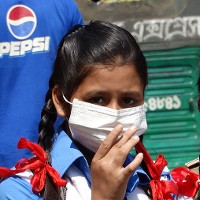Air pollution and health
A new partner in this initiative for 2013 was L'Institut National de l'Environnement Industriel et des Risques (INERIS) in France which helped develop future scenarios of air pollution in Europe. A policy report was successfully completed and selected for a well attended press conference at the European Geosciences Union (EGU) General Assembly in Vienna in 2013.
New methodologies, such as the rule-based downscaling of pollutant emission projections, taking into consideration spatial pollution-control policies based on dynamic maps of human exposure, have helped ENE to carve out a niche in globally comprehensive air pollution assessments.
Pioneering contributions in the field of energy-related health impacts included the work spearheaded by Shonali Pachauri and Shilpa Rao, which provided the first fully integrated assessment of indoor and outdoor air pollution.
Research findings stress the need for better integration of policies for effective air pollution control. In fact, pollution control measures across all sectors need to be tightened beyond those in present and planned legislation in order to meet World Health Organization (WHO) air quality standards.
Estimated global costs to meet the air pollution target are about 10–20% of energy costs and could result in about 20-30 million disability-adjusted life years saved in 2030. This estimate accounts for the ancillary benefits of stringent climate change mitigation policies that reduce overall pollution control costs by about 50–65%. In addition to aforementioned reports, results of the air pollution work were published in various peer-reviewed journals in 2013 [1] [2] [3].
References
[1] Rao S, Pachauri S, Dentener F, Kinney P, Klimont Z, Riahi K, Schoepp W (2013). Better air for better health: Forging synergies in policies for energy access, climate change and air pollution, Global Environmental Change, (in press), doi:10.1016/j.gloenvcha.2013.05.003.
[2] Colette A, Bessagnet B, Vautard R, Szopa S, Rao S, Schucht S, Klimont Z, Menut L, Clain G, Meleux F, Curci G, Rouïl L (2013). European atmosphere in 2050, a regional air quality and climate perspective under CMIP5 scenarios, Atmospheric Chemistry and Physics Discussion, 13:7451-7471, doi:10.5194/acp-13-7451-2013..
[3] Dholakia HH, Purohit P, Rao S, Garg A (2013). Impact of current policies on future air quality and health outcomes in Delhi, India. Atmospheric Environment, 75:241-248, doi:10.1016/j.atmosenv.2013.04.052.
Collaborators
Joint Research Centre, Ispra, Italy;
Columbia University, USA;
Institut National de l'Environnement Industriel et des Risques (INERIS), France.
Research program


